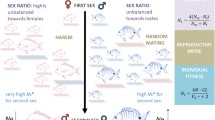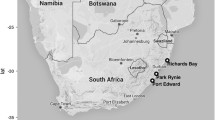Abstract
Phenotypic plasticity in sex allocation enables organisms to maximize reproductive success in variable environments, and thus may generate different sex allocation patterns among populations that experience different mating opportunities. In this experiment, I test whether sex allocation is phenotypically plastic in Serranus tortugarum, a simultaneously hermaphroditic fish, by using reciprocal transplants among four reef study sites with populations at high and low densities and significant differences in sex allocation. Fish transplanted across different densities were predicted to alter sex allocation and body size through trade-offs in investments to somatic growth and male and/or female reproduction. As a control for effects of transplanting, I also transplanted fish across study sites with the same densities and marked and returned fish to their original study sites. As predicted, sex allocation and body size shifted significantly for fish transplanted across different densities but not for those transplanted across the same densities. Separate analyses revealed that the treatment effect on sex allocation was driven strongly by a reduction in male investment by fish transplanted from high to low density, and this reduction in male investment was accompanied by an increase in body size. Fish transplanted from low to high density did not appear to change either male or female investments, but they were smaller than transplants from low to low density. A trade-off between male and female function was not evident, but phenotypic plasticity in body size suggested a trade-off between growth and male function when sex allocation is adjusted. Large-scale empirical tests of sex allocation in the field are relatively rare, and the results of this experiment give novel insights into how animals respond to a change in mating opportunities under natural conditions. The effects of logistical problems associated with fieldwork, such as mortality of experimental animals, are considered in the discussion.


Similar content being viewed by others
References
Brauer VS, Schärer L, Michiels NK (2007) Phenotypically flexible sex allocation in a simultaneous hermaphrodite. Evolution 61:216–222
Cadet C, Metz JA, Klinkhamer PGL (2004) Size and the not-so-single sex: disentangling the effects of size and budget on sex allocation in hermaphrodites. Am Nat 164:779–792
Charnov EL (1979) Simultaneous hermaphroditism and sexual selection. Proc Natl Acad Sci USA 76:2480–2484
Charnov EL (1982) The theory of sex allocation. Princeton University Press, Princeton
Charnov EL, Bull JJ, Smith JM (1976) Why be a hermaphrodite? Nature 263:125–126
Crean AJ, Marshall DJ (2008) Gamete plasticity in a broadcast spawning marine invertebrate. Proc Natl Acad Sci USA 105:13508–13513
DeWitt TJ, Sih A, Wilson DS (1998) Costs and limits to phenotypic plasticity. TREE 13:77–81
Fischer EA (1980) The relationship between mating system and simultaneous hermaphroditism in the coral reef fish, Hypoplectrus nigricans (Serranidae). Anim Behav 28:620–633
Fischer EA (1981) Sexual allocation in a simultaneously hermaphroditic coral reef fish. Am Nat 117:64–82
Fischer EA (1984a) Local mate competition and sex allocation in simultaneous hermaphrodites. Am Nat 124:590–596
Fischer EA (1984b) Egg trading in the chalk bass, Serranus tortugarum, a simultaneous hermaphrodite. Z Tierpsychol 66:143–151
Hart MK, Kratter AW, Svoboda AM et al (2010) Sex allocation in a group-living simultaneous hermaphrodite: effects of density at two spatial scales. Evol Ecol Res 12:189–202
Hart MK, Mancilla-Cortez D, Svoboda AM (2011a) Phenotypic plasticity in a simultaneously hermaphroditic coral reef fish. Coral Reefs 30:543–548
Hart MK, Shenoy K, Crowley PH (2011b) Sexual conflicts along gradients of density and predation risk: insights from an egg-trading fish. Evol Ecol 25:1080–1105
Hoch JM (2009) Adaptive plasticity of the penis in a simultaneous hermaphrodite. Evolution 63:1946–1953
Janicke T, Marie-Orleach L, De Mulder K et al (2013) Sex allocation adjustment to mating group size in a simultaneous hermaphrodite. Evolution 67:3233–3242
Klinkhammer PGL, de Jong TJ, Metz H (1997) Sex and size in cosexual plants. TREE 12:260–265
Koene JM, Montagne-Wajer K, Ter Maat A (2006) Effects of frequent mating on sex allocation in the simultaneously hermaphroditic great pond snail (Lymnaea stagnalis). Behav Ecol Sociobiol 60:332–338
Lorenzi MC, Sella G, Schleicherová D et al (2005) Outcrossing hermaphroditic polychaete worms adjust their sex allocation to social conditions. J Evol Biol 18:1341–1347
Lorenzi MC, Schleicherová D, Sella G (2006) Life history and sex allocation in the simultaneously hermaphroditic polychaete worm Ophryotrocha diadema: the role of sperm competition. Integr Comp Biol 46:381–389
Petersen CW (1991) Sex allocation in hermaphroditic sea basses. Am Nat 138:650–667
Petersen CW, Fischer EA (1996) Intraspecific variability in sex allocation in a simultaneous hermaphrodite: the effect of individual size. Evolution 50:636–645
Piersma T, Drent J (2003) Phenotypic plasticity and the evolution of organismal design. TREE 18:228–233
Raimondi PT, Martin JE (1991) Evidence that mating group size affects allocation of reproductive resources in a simultaneous hermaphrodite. Am Nat 138:1206–1217
Schärer L (2009) Tests of sex allocation theory in simultaneously hermaphroditic animals. Evolution 63:1–28
Schärer L, Ladurner P (2003) Phenotypically plastic adjustment of sex allocation in a simultaneous hermaphrodite. Proc R Soc Lond B 270:935–941
Schärer L, Sandner P, Michiels NK (2005) Trade-off between male and female allocation in the simultaneously hermaphroditic flatworm Macrostomum sp. J Evol Biol 18:396–404
Schleicherová D, Sella G, Meconcelli S et al (2014) Does the cost of a function affect its degree of plasticity? A test on plastic sex allocation in three closely related species of hermaphrodites. J Exp Mar Biol Ecol 453:148–153
Sella G, Lorenzi MC (2003) Increased sperm allocation delays body growth in a protandrous simultaneous hermaphrodite. Biol J Linn Soc 78:149–154
Tan GN, Govedich FR, Burd M (2004) Social group size, potential sperm competition and reproductive investments in a hermaphroditic leech, Helobdella papillornata (Euhirudinea: Glossiphoniidae). J Evol Biol 17:574–580
Trouvé S, Jourdane J, Renaud F et al (1999) Adaptive sex allocation in a simultaneous hermaphrodite. Evolution 53:1599–1604
Vizoso DB, Schärer L (2007) Resource-dependent sex-allocation in a simultaneous hermaphrodite. J Evol Biol 20:1046–1055
Warner RR (1991) The use of phenotypic plasticity in coral reef fishes as tests of theory in evolutionary ecology. In: Sale PF (ed) The ecology of fishes on coral reefs. Academic Press, San Diego, pp 387–398
Warner RR (1997) Evolutionary ecology: how to reconcile pelagic dispersal with local adaptation. Coral Reefs 16:S1115–S1120
Warner RR, Robertson DR, Leigh EG (1975) Sex change and sexual selection. Science 190:633–638
West-Eberhard MJ (1989) Phenotypic plasticity and the origin of diversity. Annu Rev Ecol Syst 20:249–278
Yund PO, Marcum Y, Stewart-Savage J (1997) Life-history variation in a colonial ascidian: broad-sense heritabilities and tradeoffs in allocation to asexual growth and male and female reproduction. Biol Bull 192:290–299
Zhang DY, Jiang XH (2002) Size-dependent resource allocation and sex allocation in herbaceous perennial plants. J Evol Biol 15:74–83
Acknowledgments
This study was conducted while the author was funded by pre-doctoral fellowship from the Smithsonian Tropical Research Institute. Additional financial support was provided by a Dissertation Year Fellowship from the University of Kentucky (UK) Graduate School, UK Graduate School Research Awards, UK Biology Ribble Research Fund Awards, an American Association of Underwater Sciences’ Kathy Johnston Fellowship, an American Society of Ichthyologists and Herpetologists’ Raney Fund Award, and an Animal Behavior Society Research Award. Andrew Kratter, Cara Lawrence, Marieke Keller, and Benjamin Williams provided assistance with diving and sample processing. Craig Sargent, Dave Westneat, and Phil Crowley helped tremendously with the experimental design and statistical analysis, as well as with manuscript development and enthusiastic support. Jane Brockmann, Chuck Fox, Kay Shenoy, and Colette St. Mary and her lab members gave helpful advice on presentations of the results and writing of the manuscript. Colette St. Mary was especially helpful with recent revisions. I thank John Endler, Martin Reichard, and two anonymous reviewers for recognizing the value of this work and for improving the clarity of the text with constructive advice.
Author information
Authors and Affiliations
Corresponding author
Rights and permissions
About this article
Cite this article
Hart, M.K. Phenotypic plasticity in sex allocation and body size leads to trade-offs between male function and growth in a simultaneously hermaphroditic fish. Evol Ecol 30, 173–190 (2016). https://doi.org/10.1007/s10682-015-9804-5
Received:
Accepted:
Published:
Issue Date:
DOI: https://doi.org/10.1007/s10682-015-9804-5




